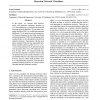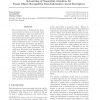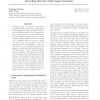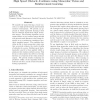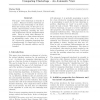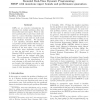133
click to vote
ICML
2005
IEEE
16 years 1 months ago
2005
IEEE
In this paper we describe a new method to reduce the complexity of support vector machines by reducing the number of necessary support vectors included in their solutions. The red...
105
Voted
ICML
2005
IEEE
16 years 1 months ago
2005
IEEE
In this paper, we compare both discriminative and generative parameter learning on both discriminatively and generatively structured Bayesian network classifiers. We use either ma...
ICML
2005
IEEE
16 years 1 months ago
2005
IEEE
Many real-world domains exhibit rich relational structure and stochasticity and motivate the development of models that combine predicate logic with probabilities. These models de...
94
Voted
ICML
2005
IEEE
16 years 1 months ago
2005
IEEE
The current framework of reinforcement learning is based on maximizing the expected returns based on scalar rewards. But in many real world situations, tradeoffs must be made amon...
113
click to vote
ICML
2005
IEEE
16 years 1 months ago
2005
IEEE
This work provides a framework for learning sequential attention in real-world visual object recognition, using an architecture of three processing stages. The first stage rejects...
113
Voted
ICML
2005
IEEE
16 years 1 months ago
2005
IEEE
Chord progressions are the building blocks from which tonal music is constructed. Inferring chord progressions is thus an essential step towards modeling long term dependencies in...
83
Voted
ICML
2005
IEEE
16 years 1 months ago
2005
IEEE
Learning agents can improve performance cooperating with other agents, particularly learning agents forming a committee outperform individual agents. This "ensemble effect&qu...
94
Voted
ICML
2005
IEEE
16 years 1 months ago
2005
IEEE
We consider the task of driving a remote control car at high speeds through unstructured outdoor environments. We present an approach in which supervised learning is first used to...
72
Voted
ICML
2005
IEEE
16 years 1 months ago
2005
IEEE
This paper views clusterings as elements of a lattice. Distances between clusterings are analyzed in their relationship to the lattice. From this vantage point, we first give an a...
94
Voted
ICML
2005
IEEE
16 years 1 months ago
2005
IEEE
MDPs are an attractive formalization for planning, but realistic problems often have intractably large state spaces. When we only need a partial policy to get from a fixed start s...

